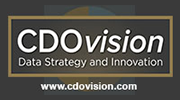 What is Big Data and how can Data Visualization help enterprises leverage their Big Data assets better? Some people know what that buzzword really means, whereas others just claim to know what it means so they won’t look inferior in the eyes of others. While it is a trending topic, the reality of Big Data still remains elusive to many businesses and data professionals alike. Speaker Robert Abate, the Global Director of the Kimberly-Clark Corporation, described the ignorance towards Big Data during his presentation titled “The Wisdom of Data Visualization,” that took place at the DATAVERSITY® CDOVision 2015 Conference in Washington, D.C. Robert Abate stated that the topic of Big Data, and the apparent mystery about it, could be likened to a teenage relationship:
What is Big Data and how can Data Visualization help enterprises leverage their Big Data assets better? Some people know what that buzzword really means, whereas others just claim to know what it means so they won’t look inferior in the eyes of others. While it is a trending topic, the reality of Big Data still remains elusive to many businesses and data professionals alike. Speaker Robert Abate, the Global Director of the Kimberly-Clark Corporation, described the ignorance towards Big Data during his presentation titled “The Wisdom of Data Visualization,” that took place at the DATAVERSITY® CDOVision 2015 Conference in Washington, D.C. Robert Abate stated that the topic of Big Data, and the apparent mystery about it, could be likened to a teenage relationship:
“Everyone talks about it. No one really knows how to do it. It’s been the source of many rumors. Everyone thinks that everyone else is going it… So everyone claims that they’re doing it.”
But what is Big Data, by definition? Big Data typically refers to any large quantity of raw data that can be collected, stored, and analyzed through various means that reveals patterns or trends relating to behaviors – particularly that of consumers – which can be used to maximize a business’ potential. That was the point that Robert Abate made clear at the beginning of his presentation; his focus was more on utilizing Big Data effectively through the use of Data Visualizations.
Why is Big Data important?
What makes Big Data so useful to many companies is the fact that it provides answers to many questions that they didn’t even know they had in the first place, he said. In other words, it provides a point of reference. With such a massive amount of information, the data is able to be shaped or tested in any way that the company sees fit. In doing so, organizations are able to pinpoint issues in a more comprehensible form. Collecting masses of data and finding a trend within the data allows the businesses to move much more quickly, smoothly, and efficiently. It also allows them to eliminate problem areas before those previously elusive issues pull their profits or reputation through the proverbial mud.
Without the aid of data, innumerable operations, in all levels of the enterprise, could be threatened, impaired, or destroyed completely:
“Data is like the air that a company breathes. Just as humans cannot survive without oxygen, a company cannot survive without the data [air] necessary to its life. Without that air, the company would theoretically choke.”
Every company uses data; the more efficiently that a company uses its data, the more potential it has to flourish. Such truisms are not unknown, but according to Mr. Abate, many organizations have yet to really grasp such simple ideas:
“Part of the challenges we have are expressing to the business [what data can do], is how the business is really the theme. We have to figure out how to communicate and to create a direct link to them.”
Big Data, especially when used in accordance with infographics and other visual elements, also allows a company to generate those answers faster. This is ideal, because the faster that a company can generate information from their sources, the faster that they can generate their answers. Speed cannot be generated with more information alone, he said. Without someone to review that data, and make sense of it, that massive hump of data is still just raw data that holds no potential or value. Just the same, adding more eyes does not necessarily equal more spotted trends – the very same way that adding more employees does not increase productivity, but instead begins to hinder it.
So what should an enterprise do?
Increase Productivity Using Big Data and Data Visualization
If an organization can generate more beneficial visual matter, then they can increase cognition. According to an analogy employed by Mr. Abate, while many individuals work, they typically only use one computer screen. But one computer screen can only do so much: it has limitations. And with limitations, the individual cannot hone their potential. If one were to have two, or even three computer screens, their ability to multitask and come to conclusions would be increased. If their resources were increased, they could make better use of their time. When it comes to Big Data, the saying “a picture is worth a thousand words” is an understatement. It is much easier to see data in a visual/physical form than it is to comprehend it as a simple spreadsheet or in other quantitative formats.
He gave a simple and easy explanation:
“To put it simply, if sales were to go down in the southwest, then one could use another computer, or phone, to bring up the weather in the southwest. Only then would one realize that there was a snowstorm in the southwest, which gives a direct correlation as to why the sales plummeted that week. Because clearly no one is going to be buying products if they can’t reach the store!”
Why the Sudden Reliance on Big Data?
The emergence of massive quantities of cellphones, tablets, flip computers, as well as the growth of Cloud Computing, along with other data sources such as sensors and the Internet of Things, have precipitated larger masses of data than anyone has ever seen. According to figures given in the presentation, in just the last two years alone, more data has been created than in all of history. To put that factoid into perspective, consider the fact that networking computers have been around since the 1950s, and it will become much easier to see why Big Data is such a big deal.
For even more shock value, consider these numbers that Mr. Abate presented on one of his slides:
- Every sixty seconds, 98,000 tweets or more are made on Twitter.
- Every sixty seconds, 695,000 status updates are made on Facebook.
- Every sixty seconds, 11 million instant messages are sent.
- Every sixty seconds, 698,445 Google searches are made.
- Every sixty seconds, 168 million or more emails are sent.
- Every sixty seconds, 1,820 terabytes (TB) of data is created.
It is no wonder why the last two years exceeded the rest of history in terms of data creation.
All of this information is useless; however, if there is no method implemented to organize it into a Data Lake or some other way the data assets can be leveraged effectively.
Making Good Use of the Data
Understanding the attributes that the data pertains to is key to using Big Data successfully. This is otherwise known as “getting to know your customer,” so that the company can market to their customers’ needs with a much higher success rate.
He gave an example of a case study where his team helped to cleanse the data of one of their clients. They removed any unrelated or outlier data from their data sets and thus narrowed it down to one key question or demographic. In doing so, they were able to identify which of their products sold more, which of their products did not sell, and thus could be eliminated. They looked at four primary data elements: revenue, frequency, value, and tenure. Mr. Abate stressed that anything more than four elements at a time, on any given visualization, become too difficult for people to follow. By eliminating products that did not sell, they were increasing their future revenue by cutting off waste. But they could not have done any of this without utilizing Data Visualization.
Data Visualization was key. By increasing their use of visualizations, the business found the value they sought. Creating more infographics, and “more screens,” allowed them to get more information, faster. It allowed them to realize they already knew much of the information that should have been obvious before. This increased the functionality of the department because they were able to ask better questions. It created linkages between data points that seemingly didn’t have any links at all. They were able to locate the good and the bad data, and in doing so they were able to maximize their productivity as well as the value of the information they collected.
Utilizing Big Data assets properly is important for any company, no matter their size. When Big Data’s potential is maximized by employing visualizations, trends that were not seen beforehand can be located with ease. As discussed by Mr. Abate, these trends can provide “information” that can be turned into valuable “insights” such as: who their customers are, how many customers they have, who the high-value and low-value customers are, and so many others.
He ended his presentation by discussing some Key Takeaways. He stated that Big Data Visualizations are the future and that it’s necessary to use more than one “screen” to gain “brain” insights. He included a few Best Practices as well: build iteratively, combine up to four “measures” per graphic (but not more), visualize movements pictorially, and make sure to plan for extreme Web scales.
